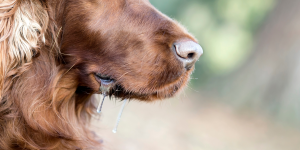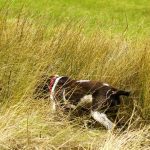Fascinating Facts About Dog Drool.
Quite apart from the fact that dog drool on the patio windows is nigh on impossible to clean off once dry, there are some rather interesting facts about canine saliva and its functions. Holidays4Dogs discovers what these are.
Dog drool may seem an odd topic of conversation and it’s a fluid that owners would definitely prefer to stay inside the dog’s mouth, rather than dribbled all over the soft furnishings! However, canine saliva has several important functions.
Functions of canine saliva.
Saliva helps dogs to cool down. Dogs can only lose heat by panting with their mouths open. Saliva soaked surfaces in the mouth help this process
by increasing evaporation and, therefore, heat from the body. Surprisingly, dog drool does have certain cleansing properties – while the action of a dog licking a wound for, example, can remove surface debris, studies have found that saliva in dogs also has antibacterial properties.
Specifically, these guard against Escherichia coli and streptococcus canis, both of which new-born puppies are susceptible to.
That said, it is not wise to allow your dog to lick your own wounds in the hope he may help to heal them.
Dog saliva also contains not so good bacteria and a dog that constantly ‘worries’ a wound can actually make it so moist it attracts bacteria and becomes very infected indeed.
Saliva production has an important role to play in the digestive system of all animals. In fact, without saliva, the stomach fails to begin the digestive process. The Russian scientist Ivan Pavlov made this discovery while studying dogs. The results provided proof that digestive function was connected to biological reflexes in the nervous system. This fact led Pavlov to make further interesting discoveries about the modification of biological reflexes.
Pavlov and his drooling dogs.
While conducting his studies he noticed dogs in his experiment would begin to salivate at the mere sight of scientists in white coats, delivering their food.
To prove his theory, he began to ring a bell as a signal that food was coming. Very soon he began to observe the dogs would start to drool at the sound of the bell. More surprisingly, would do so even if there was no food present.
He concluded that the biological reflex had been modified by something psychological. In this case, a sense of anticipation that food was about to arrive.
He named this ground breaking phenomenon a, ‘conditioned reflex’ and this process of learning became known as classical conditioning. It is widely used to modify the behaviour of animals, including humans.
As Pavlov discovered, saliva is necessary for effective digestion. Just as in humans, saliva keeps the mouth moist and helps to lubricate the oesophagus. As a result, this helps food slide into the stomach.
Dog saliva as an indication of health.
Excess production of saliva, however, could indicate that your dog is feeling unwell and may be about to vomit.
While saliva protects the throat when food goes down, it also protects as food comes up. This then minimizes the acids produced when being sick.
Conclusion.
Some dogs drool more than others. Certain breeds like Newfoundland’s, for example, or any dog with excess skin around their upper lips, find it more difficult to keep drool inside their mouths.
dogs drool more than others. Certain breeds like Newfoundland’s, for example, or any dog with excess skin around their upper lips, find it more difficult to keep drool inside their mouths.
Therefore, when they shake their heads, this can lead to strings of glistening dog spit being flung all over the place.
Nice.
Others, mix saliva with water from their bowl. This concoction can make the most revolting gelatinous goo which, once dribbled across the floor in copious quantities – becomes quite a slippery hazard.
Which is where we will end our little foray, into the qualities of dog drool. Please excuse me, while I get a mop…….
Oh, by the way. If after this you are wondering whether kissing your dog is a good idea – check out our other article here.



